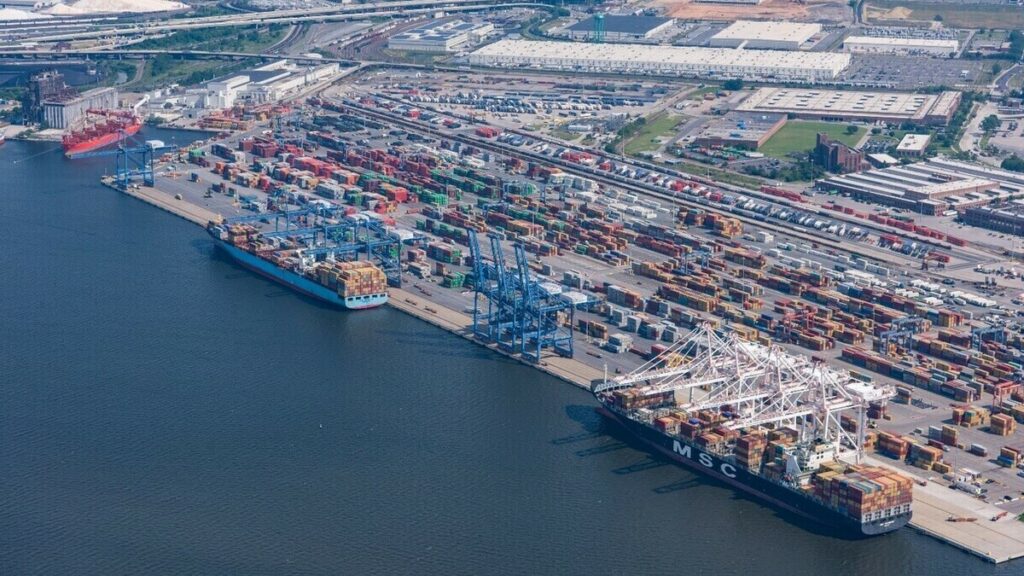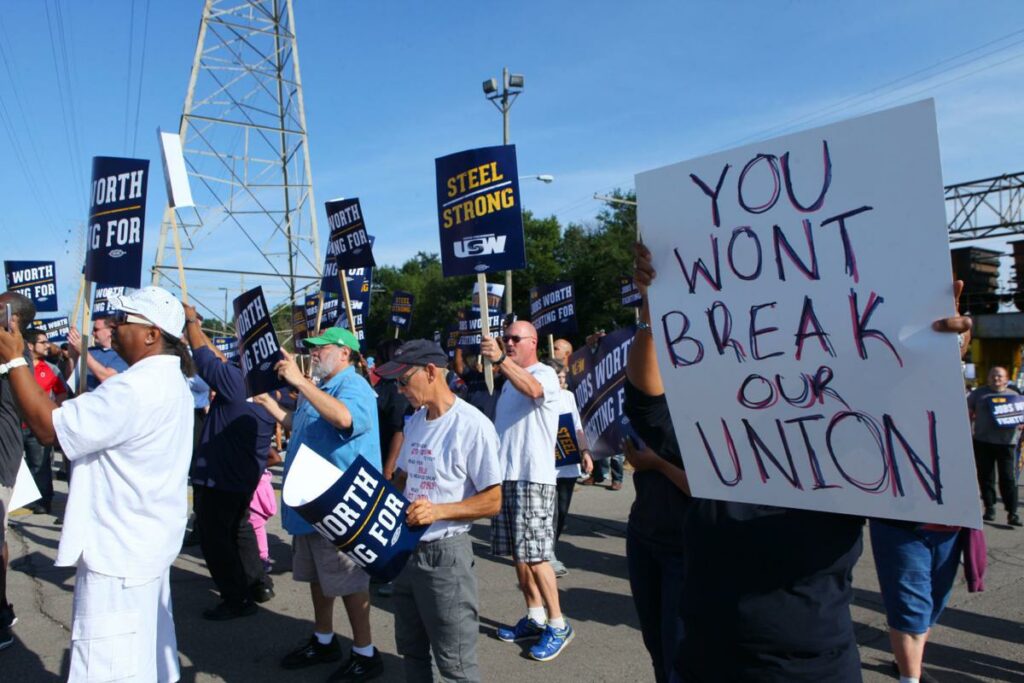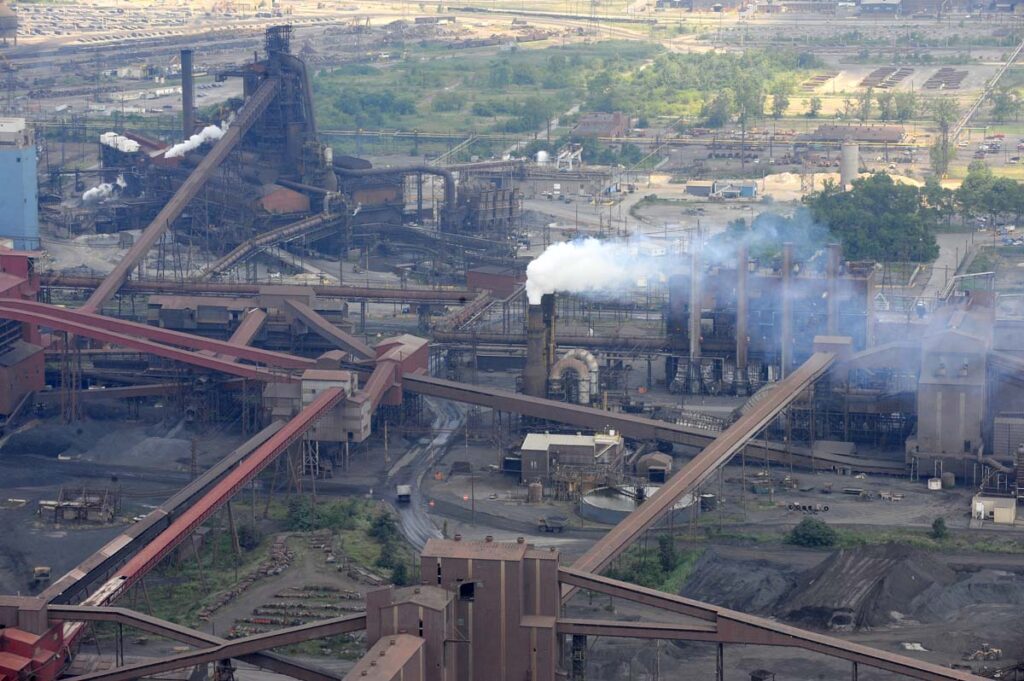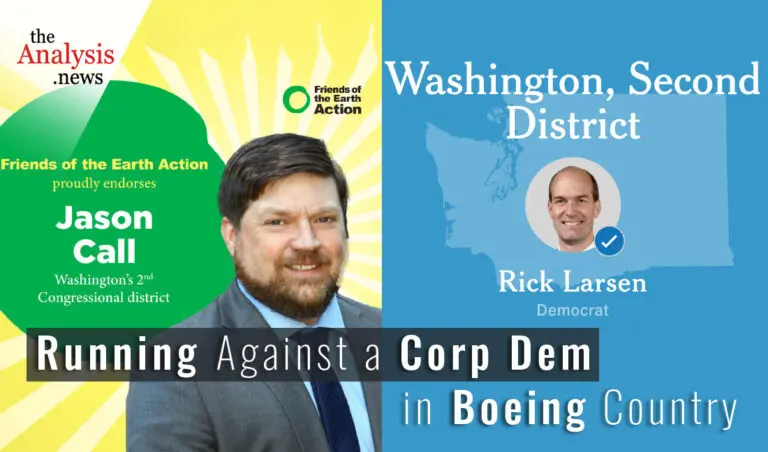This interview was originally published on February 24, 2015. Mark Reutter, author of Making Steel: Sparrows Point and the Rise and Ruin of American Industrial Might, talks about why steel production collapsed across America.
PAUL JAY, SENIOR EDITOR, TRNN: Welcome to The Real News Network, and welcome to Reality Asserts Itself. Sparrows Point is an industrial location just outside of Baltimore City. In the late 1950s, Bethlehem Steel had 30,000 people working there. By 2012, there was nobody. To help tell us the story of why and how that happened and could public policy have made a difference, joining us in the studio is Mark Reutter. Mark has been reporting and writing on Baltimore since 1970, when he started as a 19-year-old summer intern covering cops for The Evening Sun. He later moved on to The Baltimore Sun, where he was a reporter for eight years. In addition to his writings on Baltimore, he’s edited the historical magazine Railroad History and is the author of Making Steel: Sparrows Point and the Rise and Ruin of American Industrial Might. And he’s the senior writer at the Baltimore Brew, which is doing the best investigative journalism in the City of Baltimore. Thanks for joining us.
MARK REUTTER, EDITOR AND SENIOR JOURNALIST, BALTIMORE BREW: Thank you.
JAY: People are familiar who watch The Wire and see all these boarded-up houses in communities in Baltimore and the extent to which communities have been destroyed and undermined, this is a big piece of the story. A lot of the people that were living in these now boarded-up houses were working at Sparrows Point in steel.
REUTTER: Over a long time period, yes. East Baltimore was the heart of industrial Baltimore. That’s where the workforce lived. And the white workforce kind of famously lived in Highlandtown, and then in Baltimore County, in Dundalk and St. Helena. There was always–from the very beginning, one-third of the workforce consistently was employed by blacks. It dates back to the original owners’ belief that only black men could survive the blast furnace heat in the middle of summer in Maryland. They did not think any foreign–Russian or Italian–could do this. So this was a mill that always had a large black component. They had lower wages, harder work. But they settled in East Baltimore. That was their area. One of their early advocates, and who was very involved in the early unionization of Sparrows Point in the ’30s, was Thurgood Marshall, and he did a lot of his work in East Baltimore. Ironically, this black workforce finally, in the early ’70s and early ’80s, achieved parity, through a series of federal consent decrees, this very torturous process which broke down the discrimination where blacks would be stuck in black departments with lower pay scales, at that very time, there was no more work anymore. And you scratch an old Baltimore family, and they will tell you how their father or grandfather worked at Sparrows Point. And, additionally, Paul, Bethlehem Steel had an even bigger presence in Baltimore. It had a shipbuilding yard in the Inner Harbor. That was for repairs. It had a large shipbuilding yard at Sparrows Point. It had a ship breaking yard at Fairfield. It–again, when we say there were 30,000 workers at Sparrows Point, that was the Steel Mill; there was around another 6,000 workers in other facilities in the city.
JAY: Did it have to happen? If–we at The Real News, we’re trying to ask this question–if public policy at the state level, at the city level, was just–the only criteria was the interest of the majority of the people of Maryland and Baltimore, I mean, if you had had that kind of an administration, could this have been prevented? And if so, what could have, should have been done?
REUTTER: Yes, it could have been prevented, but it would have had to have been prevented, you know, 20 years before the actual demise. The last ten years, there was false hope that they could somehow survive, but it was really doomed. And the plant, fewer and fewer workers and other things was the result. What should have happened was that the government should have intervened or tried to develop–when the steel industry was faced, beginning of the 1970s, with serious problems that they said was imports and unfair competition from abroad, instead of looking into those charges and trying to chart a positive path forward, Washington and the legislations of Maryland and Ohio and Illinois and Pennsylvania just went right along with the lobbyists of both the union and the companies and began to erect these imports over and over in the ’70s and in the ’80s and the ’90s.
JAY: Import tariffs.
REUTTER: Import tariffs. One after another president or other sets this up. There’s endless litigation over did these rolled coils from Uzbekistan violate some sort of import quota. But all of that was putting the thumb in the dike, and the dike was that the industry–it wasn’t that it was even uncompetitive in cost. It’s the following. It didn’t strike out to find new markets. It lost markets.
JAY: One of the things that China was able to do–and, I believe, Japan as well–is they used a lot of public money to build the most efficient new steel. Now, I hear you saying it wasn’t all new, but a lot of it was. And, I mean, should there have been a role for this kind of public intervention? In effect, if steel is so strategic and there are so many of the jobs at stake, I mean, should public policy at some point say, you private owners are screwing this up so bad this should be public?
REUTTER: I think you could make that argument. And every other country, major country has made that argument. The French have explicitly decided on certain industries are too basic to be put into–to be let on their own to disintegrate. And that has had somewhat of a mixed record, ’cause it is very hard to change these broad economic dimensions. Throughout the Third World, after World War II, almost every government also wanted to have a steel industry, everywhere from Trinidad to Mexico, whatever. A lot of those became very botched, because it was all mixed into jobs, political programs. And so they were only partly successful.
JAY: You can talk to people in Baltimore about almost anything that has to do with crime and security and so and so, poverty; I mean, everything comes back to unemployment. And a lot of this has to do with this deindustrialization of Baltimore.
REUTTER: You’re right.
JAY: Can Baltimore reindustrialize? And if so, what would it look like?
REUTTER: Well, let me first give you a little history, because it really is a tragedy and has been so poorly underreported, I could say as a journalist. Baltimore was this major manufacturing city. And in many–one not critical but definitely contributory factor is that, remember, they located Sparrows Point in the 1880s because Baltimore was a transportation hub and was an industrial hub–not Norfolk, certainly not Charleston, certainly not Florida. Well, that’s changed. The Northeast does not consume very much steel anymore. The largest amount of steel in the country, traditional steel, is consumed by car manufacturers who have located in Mississippi and Alabama. So Sparrows Point in the last 20 years, among its other problems, lost a huge number of consuming industries. Along the waterfront in Baltimore was National Can, American Can. Continental Can had one of its biggest facilities in East Baltimore. And that was lost in the–beginning in the ’70s and in the ’80s, the time period wherein Baltimore lost its biggest population percentages. Well, what was going on in Baltimore in those days? Well, I was covering it for The Sun and I was covering it then as a journalist-historian book writer covering this, is that the city got enamored with the idea that it had to become modern, in effect deindustrialized, become a tourist center, promote and sponsor and pay huge amounts of subsidies for hotels, create the Inner Harbor, which everyone seems to love, but the number of jobs in the Inner Harbor are no greater than they once were.
JAY: But certainly they didn’t want to do this and want it to industrialize.
REUTTER: They didn’t care. And they saw–I don’t think they cared. They did not see manufacturing as anything that would come back. And so they let manufacturing companies stay by themselves but not help them. And given the fact that there’s been so many changes in manufacturing through the 1950s, vertical buildings located in the city, like the one we’re in now, where it was once used, were considered the way to run a manufacturing operation. With the advent of trucks and highways, you wanted to go out with more area and have a single-story building. So there were a lot of changes. City government didn’t catch that changes, ’cause they weren’t interested. And so what was once rimmed by industry, from Locust Point all the way around to Canton, is now rimmed with heavily subsidized apartment complexes and other things. Now, as we well know, Paul, things always are a pendulum, and they go back and forth. And there is now a fledgling movement at City Hall, at least in name, to get manufacturing plants back into Baltimore. It’s so far all been sort of smoke and mirrors. However, there has been a more significant and promising situation that’s happening at Sparrows Point. The County Executive of Baltimore County–and the plant is located just outside the city lines in Baltimore County, on the Baltimore harbor–is Kevin Kamenetz, standard kind of machine Democrat of the Maryland type, but an interesting man. And when he ran for office, first time four years ago (he was just reelected), I was struck because he said that he had been on the County Council for years. When Bethlehem Steel in the late 1990s wanted to modernize, Baltimore County gave them a big subsidy for what’s called a cold mill, and Kamenetz was involved in that. And he said candidly to the website I write for, you know, that really never worked out, and we need to really start rethinking this through. We have this fantastic facility, but to have essentially a polluting old, dangerous, old-fashioned plant with only around 2,000 workers, not 30,000, maybe isn’t good policy. He was clobbered by steelworkers, who said they would vote for the first time ever for Republicans, etc., etc. But he won election. And to his great credit, when Sparrows Point collapsed, the steelmaking, he began setting up, largely through businessmen–it was not progressive with communities, but he got some good businesspeople to start looking about, to making this into a 21st century advanced manufacturing and import hub. And that’s now actually taking place. The major hurdle is to get rid of all of this pollution that’s accumulated. But he has a good game plan. And what was striking is–and he noted it–is that we are not going to do, we, Baltimore County, are not going to do what Baltimore City did. We’re not going to turn–.
JAY: Which is?
REUTTER: Which is to turn what was once manufacturing, industrial land willy-nilly and completely into this belief that everything from casinos to hotels is–and the poor-paying jobs that are part of that–as Nirvana. And I think it’s going to be successful. This is what Baltimore is based on. It’s based on its harbor. That’s been our natural advantage over other places.
JAY: Thanks for joining us.
REUTTER: Well, thank you. I enjoyed it.
JAY: And thank you for joining us on The Real News Network.
Never miss another story
Subscribe to theAnalysis.news – Newsletter
Mark Reutter is an author and journalist. He is a senior writer at the Baltimore Brew and previously worked as a reporter at the Baltimore Sun. In addition, he is the author of Making Steel: Sparrows Point and the Rise and Ruin of American Industrial Might.









